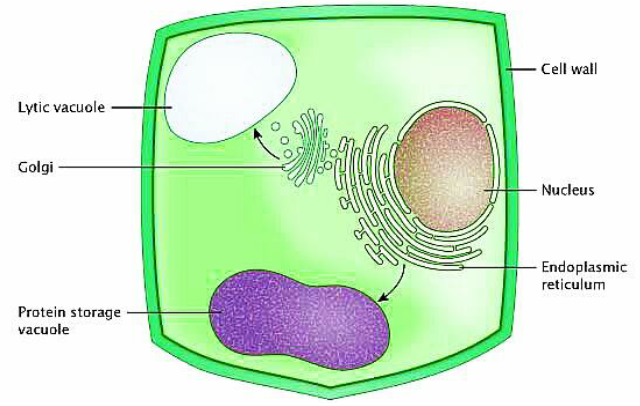
The membrane-bound, sac-like structures which store food, wastes, and water are known as
(a) Lysosomes
(b) Centrosomes
(c) Chromosomes
(d) Vacuoles
Answer
485.7k+ views
Hint: The structure helps in the phagocytosis of the pathogens entrapped by the cell.
Complete answer: The Vacuole is a membrane-bound, sac-like structure responsible for the storage of food, water, and waste material of the cell. It is present in prokaryotes like bacteria along with some fungi and animals.
Vacuole was first observed accidentally by Spallanzani in protozoa in 1776 and was later named by Dujardin.
A vacuole is formed by the fusion of numerous small vesicles derived from the tubular membranes of the cell (Golgi apparatus in eukaryotes).
It performs a variety of functions such as-
1. It acts as a storage house of the ingested food, water, and waste material.
2. It helps in maintaining the turbidity and hydrostatic pressure of the cell.
3. It helps in the maintenance of osmolarity and pH of the cytoplasm.
4.It gets modified into ‘protein bodies' in plants to store proteins needed for seed germination.
5. It helps in the lysis of denatured and misfolded proteins.
6. The plant cells possess a large central vacuole, it pushes the other organelles to cell membrane thus exposing the chloroplasts to absorb maximum sunlight.
So, the correct answer is ‘Vacuoles’.
Note:
1. The membrane of the vacuole is known as Tonoplast. It contains certain protein channels known as Aquaporins. The term tonoplast was given by de Vries in 1885.
2. In cyanobacteria, the vacuole gets modified into Gas vesicles for the storage of gases. It provides buoyancy to the bacteria inside water.

Complete answer: The Vacuole is a membrane-bound, sac-like structure responsible for the storage of food, water, and waste material of the cell. It is present in prokaryotes like bacteria along with some fungi and animals.
Vacuole was first observed accidentally by Spallanzani in protozoa in 1776 and was later named by Dujardin.
A vacuole is formed by the fusion of numerous small vesicles derived from the tubular membranes of the cell (Golgi apparatus in eukaryotes).
It performs a variety of functions such as-
1. It acts as a storage house of the ingested food, water, and waste material.
2. It helps in maintaining the turbidity and hydrostatic pressure of the cell.
3. It helps in the maintenance of osmolarity and pH of the cytoplasm.
4.It gets modified into ‘protein bodies' in plants to store proteins needed for seed germination.
5. It helps in the lysis of denatured and misfolded proteins.
6. The plant cells possess a large central vacuole, it pushes the other organelles to cell membrane thus exposing the chloroplasts to absorb maximum sunlight.
So, the correct answer is ‘Vacuoles’.
Note:
1. The membrane of the vacuole is known as Tonoplast. It contains certain protein channels known as Aquaporins. The term tonoplast was given by de Vries in 1885.
2. In cyanobacteria, the vacuole gets modified into Gas vesicles for the storage of gases. It provides buoyancy to the bacteria inside water.

Recently Updated Pages
Glucose when reduced with HI and red Phosphorus gives class 11 chemistry CBSE

The highest possible oxidation states of Uranium and class 11 chemistry CBSE

Find the value of x if the mode of the following data class 11 maths CBSE

Which of the following can be used in the Friedel Crafts class 11 chemistry CBSE

A sphere of mass 40 kg is attracted by a second sphere class 11 physics CBSE

Statement I Reactivity of aluminium decreases when class 11 chemistry CBSE

Trending doubts
10 examples of friction in our daily life

The correct order of melting point of 14th group elements class 11 chemistry CBSE

Difference Between Prokaryotic Cells and Eukaryotic Cells

One Metric ton is equal to kg A 10000 B 1000 C 100 class 11 physics CBSE

State and prove Bernoullis theorem class 11 physics CBSE

What organs are located on the left side of your body class 11 biology CBSE




